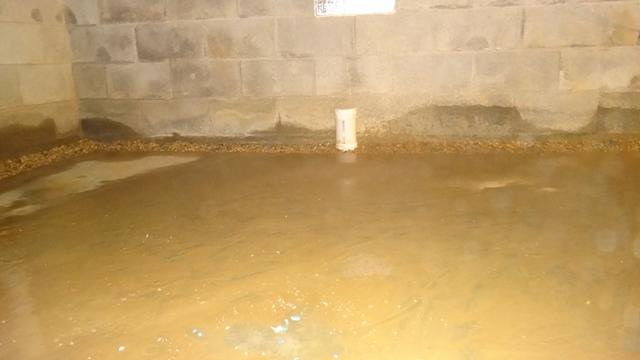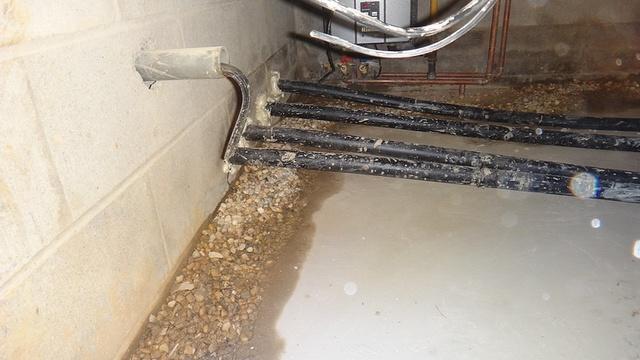
Flooded crawlspace
On the initial inspection, the DryZone designer got quite wet. There was roughly 1-2 inches of water spread throughout the entire crawlspace. Concrete floors work slightly better at keeping the water at bay than a dirt floor, but they are still prone to flooding. Once the water is in the crawlspace it will evaporate and raise the humidity. That will destroy insulation and wood. It will also let the mold and mildew spread like wildfire.

Scummy nasty water in the crawlspace
One good thing about this home is that the homeowner had no fiberglass insulation in the floor joists. If you have seen other homes in the photo gallery, you will know just how bad that stuff can get when its wet. The downside to that is that the smells from mildew and mold aren't filtered and can really stink up the whole house. This homeowner called DryZone to not only stop the water problems in his crawlspace, but to also dry the air and stop the smells and mold. The new drainage system will have no problem stopping ground water from sitting all over the crawlspace. Less standing water will hopefully mean those smells go away over time.

Hydrolink crawlspace drainage pipes
Even on the day of installation the ground is still soaked. In the distance you can see the Hydrolink inspection port. One of the unique things about DryZone's drainage systems in that they can be inspected regularly and flushed out if necessary. Other so-called solutions simply put pipes in the ground and expect homeowners to cross their fingers that the pipes won't clog. Any crawlspace pipe is going to get some dirt inside it, after all it is sitting in dirt. This is the main reason behind the drainage ports, we want you to be happy today, tomorrow, and ten years from now.

Navigating around irrigation lines and other obstacles
Things like irrigation lines and cable television wires and very common in crawlspace. Some of these things cannot simply be lifted out of the way for a few minutes. DryZone professionals work very carefully around these obstacles so they can get the drainage system installed without breaking anything.

Installing Hydrolink around the entire perimeter
Most houses these days are not made of four walls and four corners. People love to have bay windows and breakfast nooks, so the floor plan will dip out in one part and back in on another wall. This means that to waterproof the crawlspace the pipes have to angle back and forth. Would you rather have a sturdy elbow connection in your drainage system or a flexible pipe that can kink and crimp? DryZone installers carry a variety of elbow joints for our Hydrolink on the truck. That way they can select the best one for the individual corners and alcoves. This ensures that the crawlspace will be protected as best as possible.

Even the alcoves get inspection ports sometimes
Inspection ports are fairly easy to install, so why not put them on all the long straight sections of pipe? This is one of those situations where you would rather have them and never need them, rather than need them and not have them. You can also see the straight edges where the crew used jackhammers and saws to create the original trench.

Looking good is part of what DryZone does
Even though these pipes are meant to cure a water problem, they also need to look nice. This is part of the "WOW Service" that DryZone strives for everyday. The average homeowner may never see these pipes in person, but we want them to be happy regardless. It is important for everyone here to impress and amaze with every aspect of the job.

Old sump pump
This sump pump is deeper than most "stock" sump pumps. However, there were no drainage pipes leading to it so it was only handling a very small section of the house. DryZone installed a full perimeter drainage system in the crawlspace, over 300 linear feet. It would be like expecting one sump pump to pump out an entire ice rink once it melted.

New sump pump
This is 1 of 3 sump pumps installed by DryZone in this crawlspace. A sealed lid, water watch alarm, and floor drain are just a few of the upgraded features. The floor drain and alarm are designed to alert the homeowner in the event of a plumbing leak. The sealed lid will keep the standing water in the sump from leaking out and raising the humidity.

Individual discharge lines for the sump pumps
Even though the sump pumps are spread out throughout the crawlspace, we always try to discharge the water out the same side of the house. This makes for easy service and less chance that the entire yard will get soggy from water discharged through the pipes. We always try to pick a spot in the yard that isn't constantly used or slopes away from the house to discharge the sump pumps. If they discharge too close then the pumps will be trying to pump out the same water over and over again.

IceGuards for protection against freezing
Each pump's discharge line gets an IceGuard. These special fittings will keep the pipes from freezing solid in the cold weather. If they weren't attached then the pipes could crack or become clogged with ice. Clogs would cause the water to back up into the crawlspace and cause major problems.

Drying the air in the crawlspace
This is a SaniDry CX dehumidifier. It is a top of the line air system which is designed to dry AND clean the air. Every crawlspace should have one of these machines. It will lower the humidity and take most of the allergens and mold spores out of the air. There are no buckets to empty, it drains right into a sump pump.

Everlast Crawlspace Door
The old metal door was rusted and warped. DryZone has a few options for a crawlspace entry, and the Everlast is a great way to keep humid air out of the crawlspace. The last, plastic coated screws will keep the door in place and make it easy enough for you to gain access if you want. It is made from heavy vinyl so it will never warp, rust, or rot.

